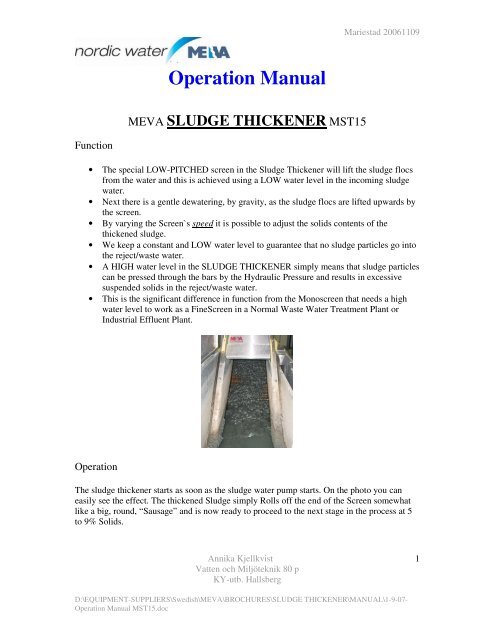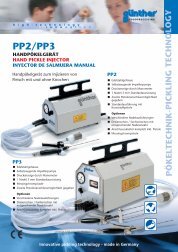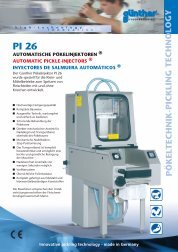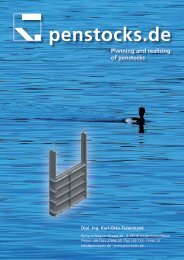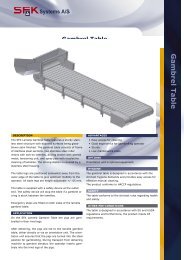SLUDGE THICKENER - Operation Manual - Stone Food Machinery
SLUDGE THICKENER - Operation Manual - Stone Food Machinery
SLUDGE THICKENER - Operation Manual - Stone Food Machinery
Create successful ePaper yourself
Turn your PDF publications into a flip-book with our unique Google optimized e-Paper software.
Mariestad 20061109<br />
<strong>Operation</strong> <strong>Manual</strong><br />
MEVA <strong>SLUDGE</strong> <strong>THICKENER</strong> MST15<br />
Function<br />
• The special LOW-PITCHED screen in the Sludge Thickener will lift the sludge flocs<br />
from the water and this is achieved using a LOW water level in the incoming sludge<br />
water.<br />
• Next there is a gentle dewatering, by gravity, as the sludge flocs are lifted upwards by<br />
the screen.<br />
• By varying the Screen`s speed it is possible to adjust the solids contents of the<br />
thickened sludge.<br />
• We keep a constant and LOW water level to guarantee that no sludge particles go into<br />
the reject/waste water.<br />
• A HIGH water level in the <strong>SLUDGE</strong> <strong>THICKENER</strong> simply means that sludge particles<br />
can be pressed through the bars by the Hydraulic Pressure and results in excessive<br />
suspended solids in the reject/waste water.<br />
• This is the significant difference in function from the Monoscreen that needs a high<br />
water level to work as a FineScreen in a Normal Waste Water Treatment Plant or<br />
Industrial Effluent Plant.<br />
<strong>Operation</strong><br />
The sludge thickener starts as soon as the sludge water pump starts. On the photo you can<br />
easily see the effect. The thickened Sludge simply Rolls off the end of the Screen somewhat<br />
like a big, round, “Sausage” and is now ready to proceed to the next stage in the process at 5<br />
to 9% Solids.<br />
Annika Kjellkvist<br />
Vatten och Miljöteknik 80 p<br />
KY-utb. Hallsberg<br />
1<br />
D:\EQUIPMENT-SUPPLIERS\Swedish\MEVA\BROCHURES\<strong>SLUDGE</strong> <strong>THICKENER</strong>\MANUAL\1-9-07-<br />
<strong>Operation</strong> <strong>Manual</strong> MST15.doc
Mariestad 20061109<br />
Level Controls for Sludge Water<br />
A level meter is placed in a pipe in the incoming sludge water and set at a level about 25 cm.<br />
The Exact level has to be adjusted, from experience, later. The level meter is used to interlock<br />
the sludge water pump to ensure the reject/waste water quality remains optimal in terms of<br />
Suspended Solids.<br />
As the pump is interlocked, the screen will continue to lift up the sludge and the pump will<br />
start when the right water level has been reached.<br />
Frequency Inverter<br />
The <strong>SLUDGE</strong> <strong>THICKENER</strong> is controlled by a Frequency Inverter with the ability to adjust<br />
the screen speed and therefore the Sludge Solids.<br />
Regulation of Dry Solids content<br />
• The variation of the Screen`s speed is used to adjust the content of dry solids in the<br />
thickened sludge.<br />
• High volumes of incoming sludge water and high speed gives a LOWER content of<br />
dry solids.<br />
• LOWER volumes of sludge water and LOW Screen speed gives a HIGHER content of<br />
solids.<br />
• The same polymer dosing can be used.<br />
• The regulation can also be done by advance knowledge of the solid contents and the<br />
quality of the incoming sludge water. Less solids gives a higher frequency and a<br />
higher speed and vice versa.<br />
<strong>Operation</strong> time<br />
<strong>Operation</strong> time depends on the load on the screen, the amount of suspended solids in the<br />
incoming sludge water and desired content of solids in the final thickened sludge. Effective<br />
use is reached with an even covering of flocculated sludge over the entire screen surface.<br />
Polymer<br />
The polymer dose is best set by eye. Clear water should be seen between the sludge flocs. If<br />
the polymer is added before the sludge pump there is enough flocculation in the pump and the<br />
Annika Kjellkvist<br />
Vatten och Miljöteknik 80 p<br />
KY-utb. Hallsberg<br />
2<br />
D:\EQUIPMENT-SUPPLIERS\Swedish\MEVA\BROCHURES\<strong>SLUDGE</strong> <strong>THICKENER</strong>\MANUAL\1-9-07-<br />
<strong>Operation</strong> <strong>Manual</strong> MST15.doc
Mariestad 20061109<br />
following pipe. To increase the flocculation effect, two rubber cloths with a cross-cut, can be<br />
mounted in flanges along the pipe run to the <strong>SLUDGE</strong> <strong>THICKENER</strong> TANK.<br />
Reject water quality<br />
• A suspended solids meter in the reject water is set to alarm at a pre-set solids content.<br />
• This alarm is used to indicate that a manual inspection of the <strong>SLUDGE</strong> <strong>THICKENER</strong><br />
and an adjustment of the polymer dose may well be required.<br />
• The suspended solids meter will not regulate the polymer dose as it can give the<br />
opposite effect than that required !<br />
• Both under and over dose of polymer can give suspended solids in the reject/waste<br />
water so care and attention is required.<br />
• A maintenance technician needs to check if and when the alarm is triggered.<br />
• The Suspended Solids meter will ensure that there is not too much suspended solids in<br />
the reject/waste water.<br />
• We expect a solids content in reject/waste water to be < 100 mg/l.<br />
Loading of the <strong>SLUDGE</strong> <strong>THICKENER</strong><br />
• The loading of the sludge thickener will be calculated by the amount of sludge as kg<br />
solids/h.<br />
• Recommended load is 125 kg solids/h for model MST 15-50-1.Maximum load is 150<br />
kg solids/h for model MST 15-50-1.<br />
• Loading will vary with the size of each particular Sludge Thickener Model<br />
Example:<br />
• 10 m 3 sludge water with 1% solids contains about 120 kg solids.<br />
• 20 m 3 sludge water with 2% solids contains about 480 kg solids<br />
• One client loads the waste water with 90 gram solids/day !!<br />
• Industrial waste water can give different loads and has to be calculated.<br />
Maintenance<br />
Regular inspection – On a monthly basis.<br />
Check that:<br />
• The screen goes freely and quietly<br />
• The screen’s electric controls are working properly.<br />
Annika Kjellkvist<br />
Vatten och Miljöteknik 80 p<br />
KY-utb. Hallsberg<br />
3<br />
D:\EQUIPMENT-SUPPLIERS\Swedish\MEVA\BROCHURES\<strong>SLUDGE</strong> <strong>THICKENER</strong>\MANUAL\1-9-07-<br />
<strong>Operation</strong> <strong>Manual</strong> MST15.doc
Mariestad 20061109<br />
• Rinse the pipe to the level meter and the edges at the incoming sludge water area.<br />
• The bar screen is clear so that no screenings can build up and cause blockage between<br />
the bars. This is especially important for the section closest to the bottom of the<br />
thickener.<br />
• There is no sand or gravel in front of the bars.<br />
• Power Hose the face of the Screen at least once every two weeks<br />
Lubrication:<br />
• The machine is equipped with a bearing lubrication system and should be greased<br />
manually every month. Be careful as over greasing is not good for the bearings. The<br />
opposite is also true !!<br />
• The worn gear transmission oil should be changed once every one/two years<br />
depending on use.<br />
• Use SHELL OMALA 680 or equivalent.<br />
Thorough inspection – Once a year:<br />
• Wear components should be inspected and replaced if necessary. Wear<br />
components have a lifetime between one and seven years.<br />
• The following parts are considered as wear components:<br />
• Connecting rod bearings and axel bearing.<br />
• Slide pad and lower cross member slide plate.<br />
• Intermediate bar spacers.<br />
• The inlet and blade spacer and the discharge end blade spacer.<br />
Also check:<br />
• The bar units, their position and if they are straight.<br />
• The worm gear transmission.<br />
• That the screen can work freely and without noise.<br />
After inspection and service, re-fit, close and lock all covers!<br />
Annika Kjellkvist<br />
Vatten och Miljöteknik 80 p<br />
KY-utb. Hallsberg<br />
4<br />
D:\EQUIPMENT-SUPPLIERS\Swedish\MEVA\BROCHURES\<strong>SLUDGE</strong> <strong>THICKENER</strong>\MANUAL\1-9-07-<br />
<strong>Operation</strong> <strong>Manual</strong> MST15.doc
Mariestad 20061109<br />
Annika Kjellkvist<br />
Vatten och Miljöteknik 80 p<br />
KY-utb. Hallsberg<br />
5<br />
D:\EQUIPMENT-SUPPLIERS\Swedish\MEVA\BROCHURES\<strong>SLUDGE</strong> <strong>THICKENER</strong>\MANUAL\1-9-07-<br />
<strong>Operation</strong> <strong>Manual</strong> MST15.doc
Mariestad 20061109<br />
Annika Kjellkvist<br />
Vatten och Miljöteknik 80 p<br />
KY-utb. Hallsberg<br />
6<br />
D:\EQUIPMENT-SUPPLIERS\Swedish\MEVA\BROCHURES\<strong>SLUDGE</strong> <strong>THICKENER</strong>\MANUAL\1-9-07-<br />
<strong>Operation</strong> <strong>Manual</strong> MST15.doc


